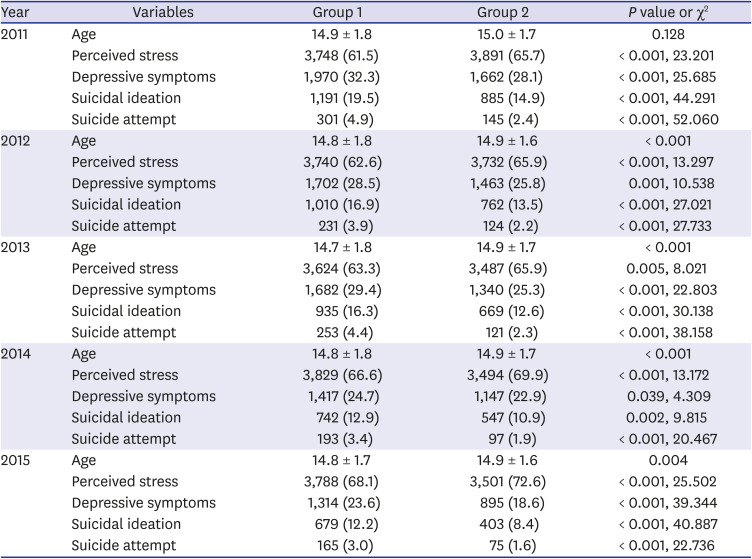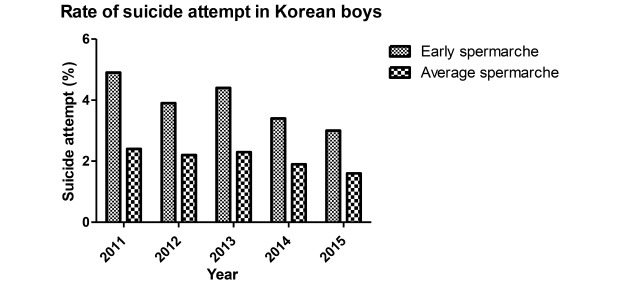1. Jeon HJ, Bae J, Woo JM. Recent statistics and risk factors of suicide in children and adolescents. J Korean Med Assoc. 2013; 56(2):93.

2. Ahn J, Han C, Woo J, Kim G. A Study on Korean Psychiatric Disorder Research: Depression and Suicide. Seoul, Korea: National Evidence-based Healthcare Collaborating Agency;2012.
3. Park S, Cho SC, Kim BN, Kim JW, Yoo HJ, Hong JP. Increased use of lethal methods and annual increase of suicide rates in Korean adolescents: comparison with adolescents in the United States. J Child Psychol Psychiatry. 2014; 55(3):258–263. PMID:
24117689.


4. Zhang YY, Lei YT, Song Y, Lu RR, Duan JL, Prochaska JJ. Gender differences in suicidal ideation and health-risk behaviors among high school students in Beijing, China. J Glob Health. 2019; 9(1):010604. PMID:
31217964.

5. Lee Y, Lee D, Hong HJ. Gender-based multilevel analysis of influential factors for suicide attempts among at-risk non-referred adolescents in Korea. Clin Psychopharmacol Neurosci. 2020; 18(1):116–126. PMID:
31958912.



6. McLoughlin AB, Gould MS, Malone KM. Global trends in teenage suicide: 2003–2014. QJM. 2015; 108(10):765–780. PMID:
25638789.


7. Andover MS, Morris BW, Wren A, Bruzzese ME. The co-occurrence of non-suicidal self-injury and attempted suicide among adolescents: distinguishing risk factors and psychosocial correlates. Child Adolesc Psychiatry Ment Health. 2012; 6(1):11. PMID:
22463065.



8. Rice TR, Sher L. Adolescent suicide and testosterone. Int J Adolesc Med Health. 2015; 29(4):20150058.

9. Mann JJ, Huang YY, Underwood MD, Kassir SA, Oppenheim S, Kelly TM, et al. A serotonin transporter gene promoter polymorphism (5-HTTLPR) and prefrontal cortical binding in major depression and suicide. Arch Gen Psychiatry. 2000; 57(8):729–738. PMID:
10920459.


10. Hayward C, Sanborn K. Puberty and the emergence of gender differences in psychopathology. J Adolesc Health. 2002; 30(4):Suppl. 49–58. PMID:
11943575.


11. Kaltiala-Heino R, Marttunen M, Rantanen P, Rimpelä M. Early puberty is associated with mental health problems in middle adolescence. Soc Sci Med. 2003; 57(6):1055–1064. PMID:
12878105.


12. Graber JA. Pubertal timing and the development of psychopathology in adolescence and beyond. Horm Behav. 2013; 64(2):262–269. PMID:
23998670.


13. Mendle J, Turkheimer E, Emery RE. Detrimental psychological outcomes associated with early pubertal timing in adolescent girls. Dev Rev. 2007; 27(2):151–171. PMID:
20740062.



14. Graber JA, Seeley JR, Brooks-Gunn J, Lewinsohn PM. Is pubertal timing associated with psychopathology in young adulthood. J Am Acad Child Adolesc Psychiatry. 2004; 43(6):718–726. PMID:
15167088.


15. Lee D, Ahn IY, Park CS, Kim BJ, Lee CS, Cha B, et al. Early menarche as a risk factor for suicidal ideation in girls: the Korea youth risk behavior web-based survey. Psychiatry Res. 2020; 285:112706. PMID:
31810746.

16. Lee EY, Pabayo R, Kawachi I. Timing of spermarche and menarche are associated with physical activity and sedentary behavior among Korean adolescents. Osong Public Health Res Perspect. 2016; 7(4):266–272. PMID:
27635377.



17. Mendle J, Ferrero J. Detrimental psychological outcomes associated with pubertal timing in adolescent boys. Dev Rev. 2012; 32(1):49–66.

18. Sisk CL, Zehr JL. Pubertal hormones organize the adolescent brain and behavior. Front Neuroendocrinol. 2005; 26(3-4):163–174. PMID:
16309736.


19. Schulz KM, Molenda-Figueira HA, Sisk CL. Back to the future: the organizational-activational hypothesis adapted to puberty and adolescence. Horm Behav. 2009; 55(5):597–604. PMID:
19446076.



20. Steinberg L. A social neuroscience perspective on adolescent risk-taking. Dev Rev. 2008; 28(1):78–106. PMID:
18509515.



21. Casey BJ, Jones RM, Hare TA. The adolescent brain. Ann N Y Acad Sci. 2008; 1124(1):111–126. PMID:
18400927.



22. Dahl RE. Adolescent brain development: a period of vulnerabilities and opportunities. Keynote address. Ann N Y Acad Sci. 2004; 1021(1):1–22. PMID:
15251869.


23. Hankin BL, Abela JR. Development of Psychopathology: a Vulnerability-Stress Perspective. Thousand Oaks, CA: Sage Publications;2005.
24. Athey A, Overholser J, Bagge C, Dieter L, Vallender E, Stockmeier CA. Risk-taking behaviors and stressors differentially predict suicidal preparation, non-fatal suicide attempts, and suicide deaths. Psychiatry Res. 2018; 270:160–167. PMID:
30253320.



25. Ammerman BA, Steinberg L, McCloskey MS. Risk-taking behavior and suicidality: the unique role of adolescent drug use. J Clin Child Adolesc Psychol. 2018; 47(1):131–141. PMID:
27732082.

26. McCoy SS, Dimler LM, Samuels DV, Natsuaki MN. Adolescent susceptibility to deviant peer pressure: does gender matter? Adolesc Res Rev. 2019; 4(1):59–71.

27. Sidlauskaite J, González-Madruga K, Smaragdi A, Riccelli R, Puzzo I, Batchelor M, et al. Sex differences in risk-based decision making in adolescents with conduct disorder. Eur Child Adolesc Psychiatry. 2018; 27(9):1133–1142. PMID:
28688012.


28. Rahmandar MH, Biro FM. Suicide, puberty, and a changing body. Int J Child Health Hum Dev. 2017; 10(4):299–304.
29. Song Y, Ma J, Wang HJ, Wang Z, Lau PW, Agardh A. Age at spermarche: 15-year trend and its association with body mass index in Chinese school-aged boys. Pediatr Obes. 2016; 11(5):369–374. PMID:
26403948.


30. World Health Organization. The Sexual and Reproductive Health of Younger Adolescents: Research Issues in Developing Countries: Background Paper for Consultation (No. WHO/RHR/11.15). Geneva, Switzerland: World Health Organization;2011.
31. Patton GC, Viner R. Pubertal transitions in health. Lancet. 2007; 369(9567):1130–1139. PMID:
17398312.


32. Wei HT, Lan WH, Hsu JW, Bai YM, Huang KL, Su TP, et al. Risk of suicide attempt among adolescents with conduct disorder: a longitudinal follow-up study. J Pediatr. 2016; 177:292–296. PMID:
27453371.


33. Brooks Holliday S, Ewing BA, Storholm ED, Parast L, D'Amico EJ. Gender differences in the association between conduct disorder and risky sexual behavior. J Adolesc. 2017; 56:75–83. PMID:
28182979.



34. American Psychiatric Association. Diagnostic and Statistical Manual of Mental Disorders. Arlington, TX: American Psychiatric Publishing;2013.







 PDF
PDF Citation
Citation Print
Print




 XML Download
XML Download